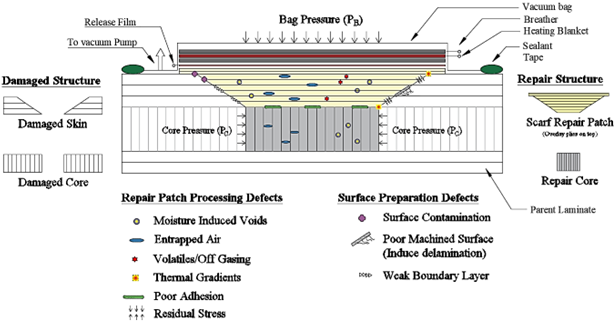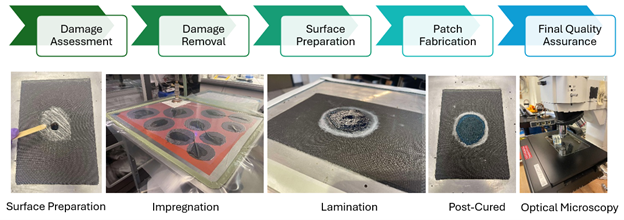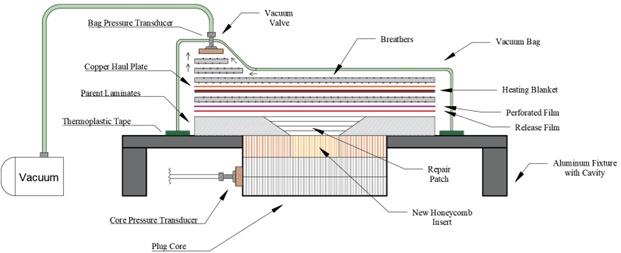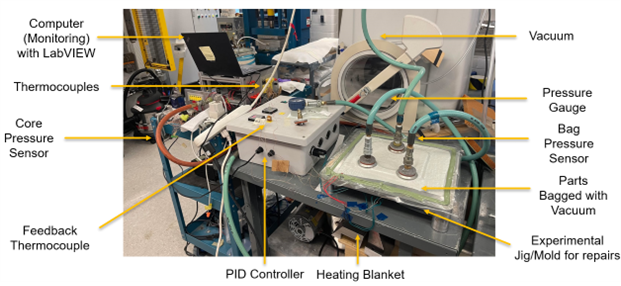
He/Him
PhD candidate
Project: Development of Robust Structural Bonded Repair Methodologies on Aerospace Component made of Thermoset Composite Sandwich Panels
LinkedIn jingcai.zhou [at] mail.mcgill.ca (Mail)
Supervisor: Prof. Pascal Hubert
Over the past decades, carbon fibre reinforced polymers (CFRPs) have increasingly replaced metals like aluminum and titanium in aircraft structures because of their high strength-to-weight ratio and fuel efficiency. However, CFRPs are prone to various types of damage, which can weaken the material and compromise structural integrity. When damage is not extensive, repairs can restore strength and durability.
Among modern repair methods, scarf repairs are preferred due to their high performance and minimal drawbacks. Wet layup is commonly used to bond the repair patch because it works well at room temperature, cures rapidly, and is adaptable for complex shapes. Although scarf repairs with wet layup are effective for thick composite sections, they require accurate processing and skilled technicians. Key factors like curing conditions, bonding methods, surface preparation, and patch fabrication must be carefully investigated to avoid errors and ensure a successful repair.
The objective of the project aims to improve the robustness of repair process, focusing on patch processing and surface bonding techniques. This will be achieved by investigating and minimizing the sources of variability in repair quality and performance in production and in-service repair environment, as shown in figure 1.
General repair procedure in aerospace industry starts with damage assessment and ends with final quality assurance, as shown in figure 2. In this project, the aircraft component being repaired has both core and skin damage. The repair involves replacing the damaged honeycomb core within the sandwich structure and restoring the skin using wet layup impregnation with a heating blanket, as illustrated in figure 3. Eventually, repair quality can be assessed though non-destructive testing methods (thermography, radiography etc.) and destructive testing (i.e. fracture toughness, tensile testing etc.)
To minimize variability in processing conditions, the influence of various process parameters was investigated during composite repair using thermocouples, pressure sensors, a Data Acquisition System (DAQ) via LabVIEW, as shown in figure 4. Key adjustable processing parameters include humidity, vacuum levels, impregnation methods, curing cycle, and bagging techniques etc. A design of experiment (DOE) approach is employed to analyze the impact of these parameters. Process-induced variability such as residual stress, thermal gradients, thermal lags, and moisture ingress are thoroughly analyzed. Overall, void distribution and tensile testing serve as the main methods to evaluate the quality of repair patch under varying processing conditions.
A range of surface preparation techniques are applied, including chemical functionalization, sanding, blasting, corona discharge, laser treatments, flame treatments, and plasma treatments. To evaluate the bonding quality using these techniques, scanning electron microscope (SEM) is used to observe surface morphology, atomic force microscope (AFM) to assess topography metrics, and Fourier-transform infrared spectroscopy (FTIR) to quantify the chemical composition after surface treatment. The DOE technique is also applied to efficiently assess the effects of surface preparation on bonding performance, as full-scale testing of bonded structure is impractical.

Figure.1 Overview of Scarf Patch Repair Process – Highlights of challenges and processing defects

Figure.2 Lab Scale: Overview of Aerospace Repair Process

Figure.3 Patch Fabrication on top of damaged prepreg laminates using experimental jig
Figure.4 